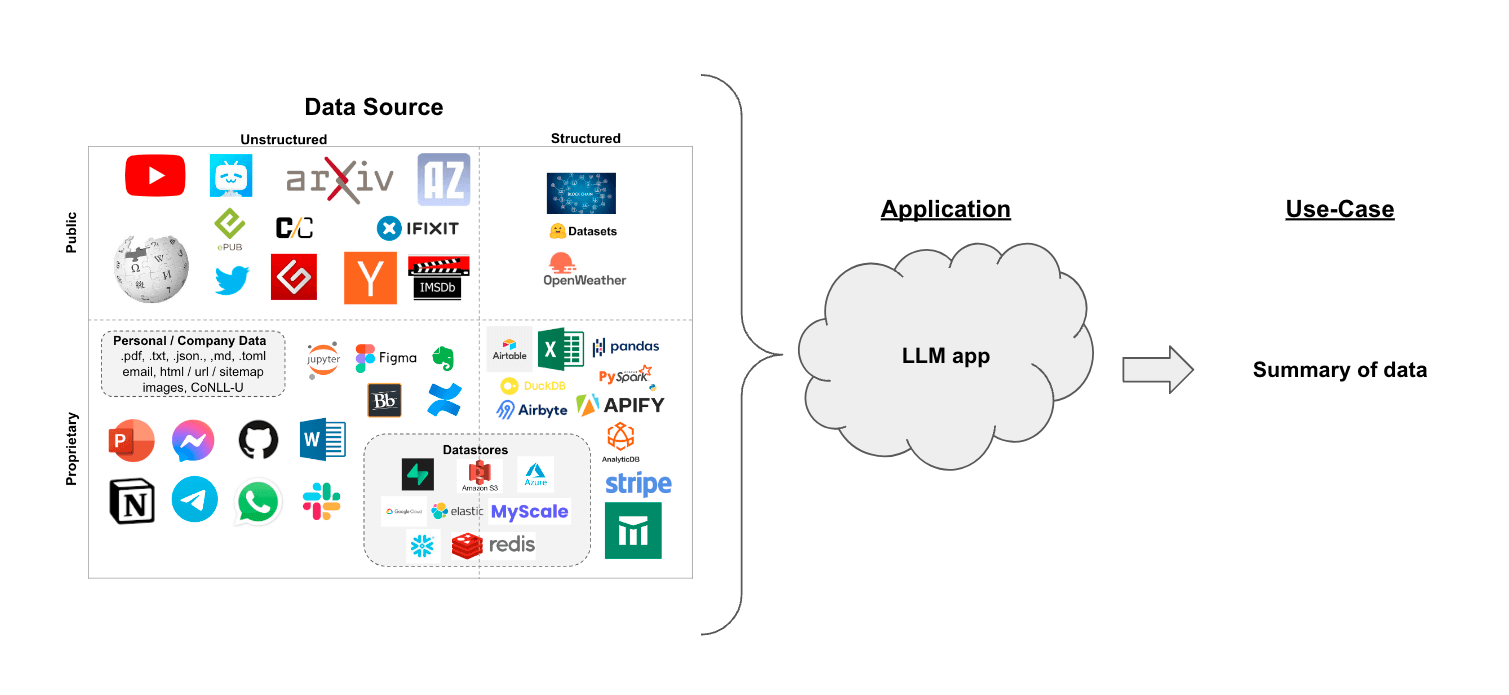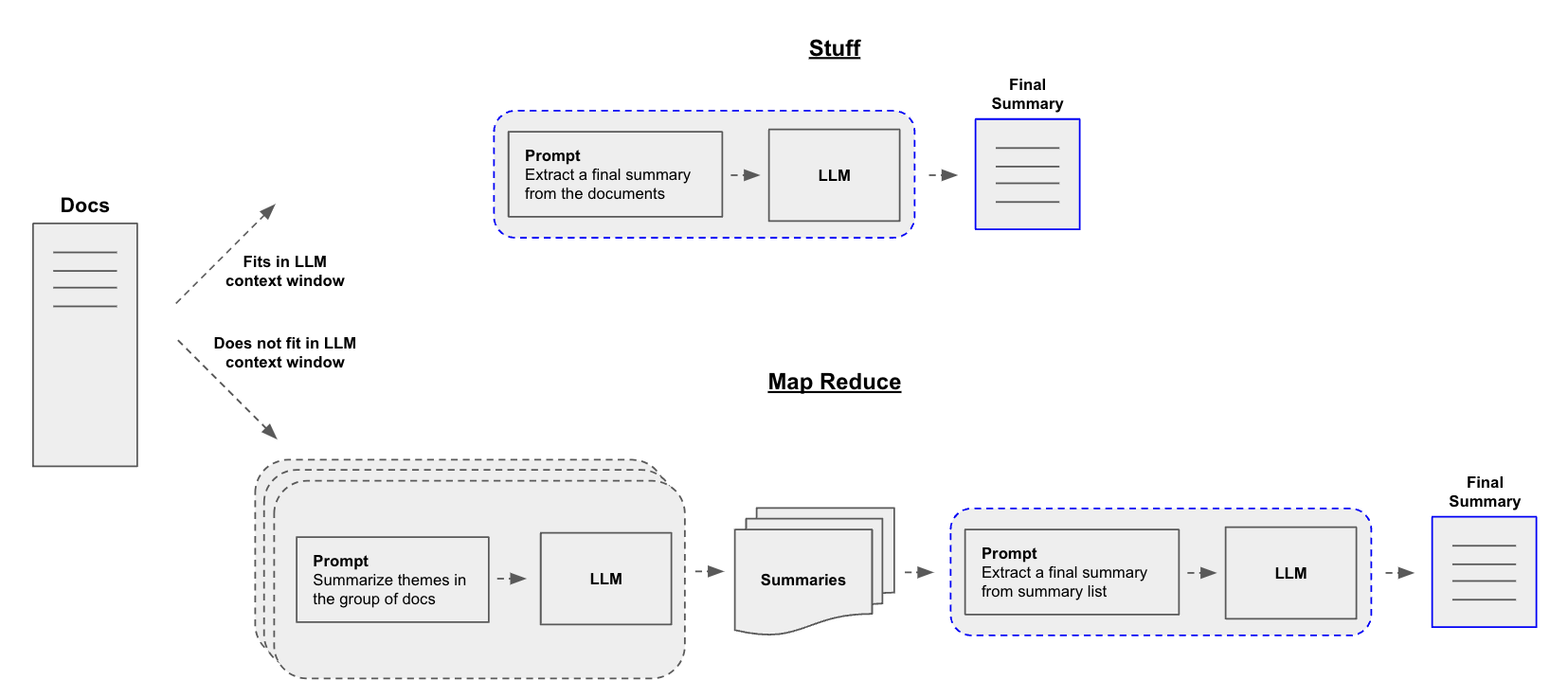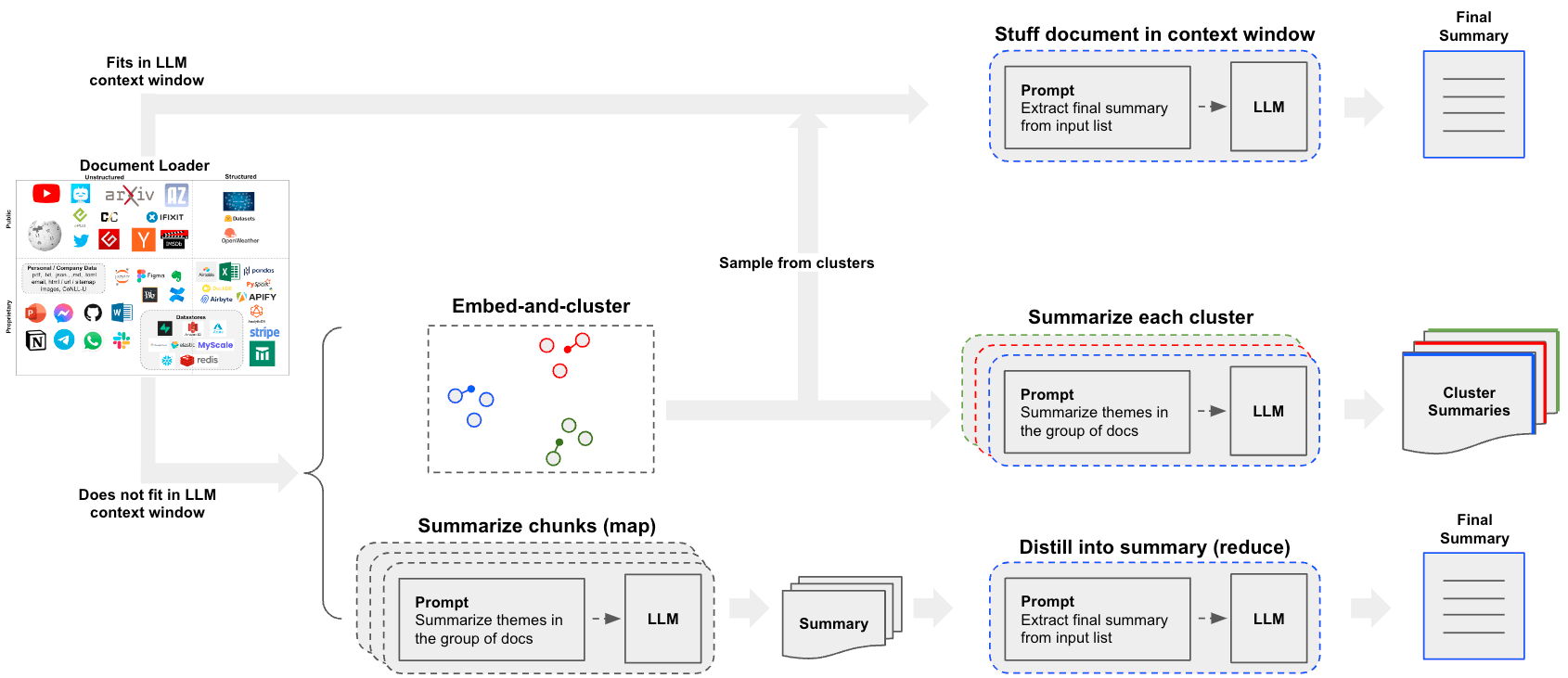文本摘要
本教程演示了如何使用内置链和 LangGraph 进行文本摘要。
此页面的先前版本展示了旧版链 StuffDocumentsChain、MapReduceDocumentsChain 和 RefineDocumentsChain。有关使用这些抽象及其与本教程中演示的方法的比较,请参阅此处。
假设您有一组文档(PDF、Notion 页面、客户问题等),并且您想总结其内容。
鉴于大型语言模型在理解和合成文本方面的熟练程度,它们是完成这项工作的绝佳工具。
在检索增强生成的背景下,总结文本可以帮助提炼大量检索到的文档中的信息,从而为大型语言模型提供上下文。
在本演练中,我们将介绍如何使用大型语言模型总结多个文档中的内容。

概念
我们将涵盖的概念有
-
使用语言模型。
-
使用文档加载器,特别是WebBaseLoader 从 HTML 网页加载内容。
-
两种总结或以其他方式组合文档的方法。
- Stuff,它简单地将文档连接成一个提示;
- Map-reduce,用于处理更大的文档集。它将文档分成批次,然后对这些批次进行总结,最后对总结结果进行再总结。
有关这些策略及其他策略(包括迭代细化)的更简短、有针对性的指南,请参阅操作指南。
设置
Jupyter Notebook
本指南(以及文档中的大多数其他指南)使用 Jupyter notebooks,并假设读者也在使用。Jupyter notebooks 非常适合学习如何使用 LLM 系统,因为通常情况下会出现问题(意外输出、API 关闭等),而在交互式环境中浏览指南是更好地理解它们的绝佳方式。
本教程和其他教程或许在Jupyter Notebook中运行最为方便。有关如何安装的说明,请参见此处。
安装
要安装 LangChain,请运行
- Pip
- Conda
pip install langchain
conda install langchain -c conda-forge
更多详情,请参阅我们的安装指南。
LangSmith
您使用 LangChain 构建的许多应用程序将包含多个步骤,其中涉及多次调用大型语言模型。随着这些应用程序变得越来越复杂,能够检查您的链或代理内部究竟发生了什么是至关重要的。实现这一目标的最佳方式是使用 LangSmith。
在上述链接注册后,请务必设置您的环境变量以开始记录跟踪日志
export LANGSMITH_TRACING="true"
export LANGSMITH_API_KEY="..."
或者,如果在Notebook中,您可以这样设置
import getpass
import os
os.environ["LANGSMITH_TRACING"] = "true"
os.environ["LANGSMITH_API_KEY"] = getpass.getpass()
概述
构建摘要器的核心问题是如何将文档传递到大型语言模型的上下文窗口。两种常见的方法是
-
Stuff:简单地将所有文档“塞入”一个提示。这是最简单的方法(有关此方法使用的create_stuff_documents_chain构造函数的更多信息,请参阅此处)。 -
Map-reduce:在“map”步骤中分别总结每个文档,然后将这些摘要“reduce”为最终摘要(有关此方法使用的MapReduceDocumentsChain的更多信息,请参阅此处)。
请注意,当子文档的理解不依赖于前面的上下文时,map-reduce 尤其有效。例如,当总结大量较短文档的语料库时。在其他情况下,例如总结小说或具有固有序列的文本主体时,迭代细化可能更有效。

设置
首先设置环境变量并安装软件包
%pip install --upgrade --quiet tiktoken langchain langgraph beautifulsoup4 langchain-community
# Set env var OPENAI_API_KEY or load from a .env file
# import dotenv
# dotenv.load_dotenv()
import os
os.environ["LANGSMITH_TRACING"] = "true"
首先我们加载文档。我们将使用 WebBaseLoader 加载一篇博客文章
from langchain_community.document_loaders import WebBaseLoader
loader = WebBaseLoader("https://lilianweng.github.io/posts/2023-06-23-agent/")
docs = loader.load()
接下来我们选择一个大型语言模型(LLM)
pip install -qU "langchain[google-genai]"
import getpass
import os
if not os.environ.get("GOOGLE_API_KEY"):
os.environ["GOOGLE_API_KEY"] = getpass.getpass("Enter API key for Google Gemini: ")
from langchain.chat_models import init_chat_model
llm = init_chat_model("gemini-2.0-flash", model_provider="google_genai")
Stuff:通过一次 LLM 调用进行摘要
我们可以使用 create_stuff_documents_chain,尤其是在使用较大上下文窗口模型时,例如
- 128k token OpenAI
gpt-4o - 200k token Anthropic
claude-3-5-sonnet-20240620
该链将获取文档列表,将其全部插入到提示中,然后将该提示传递给大型语言模型。
from langchain.chains.combine_documents import create_stuff_documents_chain
from langchain.chains.llm import LLMChain
from langchain_core.prompts import ChatPromptTemplate
# Define prompt
prompt = ChatPromptTemplate.from_messages(
[("system", "Write a concise summary of the following:\\n\\n{context}")]
)
# Instantiate chain
chain = create_stuff_documents_chain(llm, prompt)
# Invoke chain
result = chain.invoke({"context": docs})
print(result)
The article "LLM Powered Autonomous Agents" by Lilian Weng discusses the development and capabilities of autonomous agents powered by large language models (LLMs). It outlines a system architecture that includes three main components: Planning, Memory, and Tool Use.
1. **Planning** involves task decomposition, where complex tasks are broken down into manageable subgoals, and self-reflection, allowing agents to learn from past actions to improve future performance. Techniques like Chain of Thought (CoT) and Tree of Thoughts (ToT) are highlighted for enhancing reasoning and planning.
2. **Memory** is categorized into short-term and long-term memory, with mechanisms for fast retrieval using Maximum Inner Product Search (MIPS) algorithms. This allows agents to retain and recall information effectively.
3. **Tool Use** enables agents to interact with external APIs and tools, enhancing their capabilities beyond the limitations of their training data. Examples include MRKL systems and frameworks like HuggingGPT, which facilitate task planning and execution.
The article also addresses challenges such as finite context length, difficulties in long-term planning, and the reliability of natural language interfaces. It concludes with case studies demonstrating the practical applications of these concepts in scientific discovery and interactive simulations. Overall, the article emphasizes the potential of LLMs as powerful problem solvers in autonomous agent systems.
流式传输
请注意,我们还可以逐个标记地流式传输结果
for token in chain.stream({"context": docs}):
print(token, end="|")
|The| article| "|LL|M| Powered| Autonomous| Agents|"| by| Lil|ian| W|eng| discusses| the| development| and| capabilities| of| autonomous| agents| powered| by| large| language| models| (|LL|Ms|).| It| outlines| a| system| architecture| that| includes| three| main| components|:| Planning|,| Memory|,| and| Tool| Use|.|
|1|.| **|Planning|**| involves| task| decomposition|,| where| complex| tasks| are| broken| down| into| manageable| sub|go|als|,| and| self|-ref|lection|,| allowing| agents| to| learn| from| past| actions| to| improve| future| performance|.| Techniques| like| Chain| of| Thought| (|Co|T|)| and| Tree| of| Thoughts| (|To|T|)| are| highlighted| for| enhancing| reasoning| and| planning|.
|2|.| **|Memory|**| is| categorized| into| short|-term| and| long|-term| memory|,| with| mechanisms| for| fast| retrieval| using| Maximum| Inner| Product| Search| (|M|IPS|)| algorithms|.| This| allows| agents| to| retain| and| recall| information| effectively|.
|3|.| **|Tool| Use|**| emphasizes| the| integration| of| external| APIs| and| tools| to| extend| the| capabilities| of| L|LM|s|,| enabling| them| to| perform| tasks| beyond| their| inherent| limitations|.| Examples| include| MR|KL| systems| and| frameworks| like| Hug|ging|GPT|,| which| facilitate| task| planning| and| execution|.
|The| article| also| addresses| challenges| such| as| finite| context| length|,| difficulties| in| long|-term| planning|,| and| the| reliability| of| natural| language| interfaces|.| It| concludes| with| case| studies| demonstrating| the| practical| applications| of| L|LM|-powered| agents| in| scientific| discovery| and| interactive| simulations|.| Overall|,| the| piece| illustrates| the| potential| of| L|LM|s| as| general| problem| sol|vers| and| their| evolving| role| in| autonomous| systems|.||
深入了解
- 您可以轻松自定义提示。
- 您可以通过
llm参数轻松尝试不同的 LLM(例如,Claude)。
Map-Reduce:通过并行化总结长文本
我们来深入了解 MapReduce 方法。为此,我们首先使用 LLM 将每个文档映射到单独的摘要。然后,我们将这些摘要“reduce”或合并成一个单一的全局摘要。
请注意,映射步骤通常在输入文档上并行化。
基于 langchain-core 构建的 LangGraph 支持 map-reduce 工作流,并且非常适合此问题。
- LangGraph 允许单独的步骤(例如连续摘要)进行流式传输,从而更好地控制执行;
- LangGraph 的检查点支持错误恢复,通过人机协作工作流进行扩展,并更容易融入对话式应用程序。
- LangGraph 的实现易于修改和扩展,如下所示。
映射
我们首先定义与映射步骤相关的提示。我们可以使用与上述 stuff 方法相同的摘要提示。
from langchain_core.prompts import ChatPromptTemplate
map_prompt = ChatPromptTemplate.from_messages(
[("system", "Write a concise summary of the following:\\n\\n{context}")]
)
我们还可以使用 Prompt Hub 存储和获取提示。
这将与您的 LangSmith API 密钥一起使用。
例如,请参见此处的映射提示。
from langchain import hub
map_prompt = hub.pull("rlm/map-prompt")
归约
我们还定义了一个提示,该提示接受文档映射结果并将其归约为单个输出。
# Also available via the hub: `hub.pull("rlm/reduce-prompt")`
reduce_template = """
The following is a set of summaries:
{docs}
Take these and distill it into a final, consolidated summary
of the main themes.
"""
reduce_prompt = ChatPromptTemplate([("human", reduce_template)])
通过 LangGraph 进行编排
下面我们实现一个简单的应用程序,它对文档列表执行摘要步骤的映射,然后使用上述提示对其进行归约。
当文本相对于大型语言模型的上下文窗口较长时,Map-reduce 流特别有用。对于长文本,我们需要一种机制来确保归约步骤中要摘要的上下文不会超过模型的上下文窗口大小。在这里,我们实现了一个递归的摘要“折叠”:输入根据令牌限制进行分区,并生成分区的摘要。重复此步骤,直到摘要的总长度在所需限制内,从而允许对任意长度的文本进行摘要。
首先我们将博客文章分成更小的“子文档”进行映射
from langchain_text_splitters import CharacterTextSplitter
text_splitter = CharacterTextSplitter.from_tiktoken_encoder(
chunk_size=1000, chunk_overlap=0
)
split_docs = text_splitter.split_documents(docs)
print(f"Generated {len(split_docs)} documents.")
Created a chunk of size 1003, which is longer than the specified 1000
``````output
Generated 14 documents.
接下来,我们定义图。请注意,我们定义了一个人为设置的低最大令牌长度 1,000 个令牌,以说明“折叠”步骤。
import operator
from typing import Annotated, List, Literal, TypedDict
from langchain.chains.combine_documents.reduce import (
acollapse_docs,
split_list_of_docs,
)
from langchain_core.documents import Document
from langgraph.constants import Send
from langgraph.graph import END, START, StateGraph
token_max = 1000
def length_function(documents: List[Document]) -> int:
"""Get number of tokens for input contents."""
return sum(llm.get_num_tokens(doc.page_content) for doc in documents)
# This will be the overall state of the main graph.
# It will contain the input document contents, corresponding
# summaries, and a final summary.
class OverallState(TypedDict):
# Notice here we use the operator.add
# This is because we want combine all the summaries we generate
# from individual nodes back into one list - this is essentially
# the "reduce" part
contents: List[str]
summaries: Annotated[list, operator.add]
collapsed_summaries: List[Document]
final_summary: str
# This will be the state of the node that we will "map" all
# documents to in order to generate summaries
class SummaryState(TypedDict):
content: str
# Here we generate a summary, given a document
async def generate_summary(state: SummaryState):
prompt = map_prompt.invoke(state["content"])
response = await llm.ainvoke(prompt)
return {"summaries": [response.content]}
# Here we define the logic to map out over the documents
# We will use this an edge in the graph
def map_summaries(state: OverallState):
# We will return a list of `Send` objects
# Each `Send` object consists of the name of a node in the graph
# as well as the state to send to that node
return [
Send("generate_summary", {"content": content}) for content in state["contents"]
]
def collect_summaries(state: OverallState):
return {
"collapsed_summaries": [Document(summary) for summary in state["summaries"]]
}
async def _reduce(input: dict) -> str:
prompt = reduce_prompt.invoke(input)
response = await llm.ainvoke(prompt)
return response.content
# Add node to collapse summaries
async def collapse_summaries(state: OverallState):
doc_lists = split_list_of_docs(
state["collapsed_summaries"], length_function, token_max
)
results = []
for doc_list in doc_lists:
results.append(await acollapse_docs(doc_list, _reduce))
return {"collapsed_summaries": results}
# This represents a conditional edge in the graph that determines
# if we should collapse the summaries or not
def should_collapse(
state: OverallState,
) -> Literal["collapse_summaries", "generate_final_summary"]:
num_tokens = length_function(state["collapsed_summaries"])
if num_tokens > token_max:
return "collapse_summaries"
else:
return "generate_final_summary"
# Here we will generate the final summary
async def generate_final_summary(state: OverallState):
response = await _reduce(state["collapsed_summaries"])
return {"final_summary": response}
# Construct the graph
# Nodes:
graph = StateGraph(OverallState)
graph.add_node("generate_summary", generate_summary) # same as before
graph.add_node("collect_summaries", collect_summaries)
graph.add_node("collapse_summaries", collapse_summaries)
graph.add_node("generate_final_summary", generate_final_summary)
# Edges:
graph.add_conditional_edges(START, map_summaries, ["generate_summary"])
graph.add_edge("generate_summary", "collect_summaries")
graph.add_conditional_edges("collect_summaries", should_collapse)
graph.add_conditional_edges("collapse_summaries", should_collapse)
graph.add_edge("generate_final_summary", END)
app = graph.compile()
LangGraph 允许绘制图结构以帮助可视化其功能
from IPython.display import Image
Image(app.get_graph().draw_mermaid_png())
运行应用程序时,我们可以流式传输图以观察其步骤序列。下面,我们将简单地打印出步骤的名称。
请注意,由于图中有循环,因此指定执行的递归限制可能会有所帮助。当超过指定限制时,这将引发特定错误。
async for step in app.astream(
{"contents": [doc.page_content for doc in split_docs]},
{"recursion_limit": 10},
):
print(list(step.keys()))
['generate_summary']
['generate_summary']
['generate_summary']
['generate_summary']
['generate_summary']
['generate_summary']
['generate_summary']
['generate_summary']
['generate_summary']
['generate_summary']
['generate_summary']
['generate_summary']
['generate_summary']
['generate_summary']
['collect_summaries']
['collapse_summaries']
['collapse_summaries']
['generate_final_summary']
print(step)
{'generate_final_summary': {'final_summary': 'The consolidated summary of the main themes from the provided documents is as follows:\n\n1. **Integration of Large Language Models (LLMs) in Autonomous Agents**: The documents explore the evolving role of LLMs in autonomous systems, emphasizing their enhanced reasoning and acting capabilities through methodologies that incorporate structured planning, memory systems, and tool use.\n\n2. **Core Components of Autonomous Agents**:\n - **Planning**: Techniques like task decomposition (e.g., Chain of Thought) and external classical planners are utilized to facilitate long-term planning by breaking down complex tasks.\n - **Memory**: The memory system is divided into short-term (in-context learning) and long-term memory, with parallels drawn between human memory and machine learning to improve agent performance.\n - **Tool Use**: Agents utilize external APIs and algorithms to enhance problem-solving abilities, exemplified by frameworks like HuggingGPT that manage task workflows.\n\n3. **Neuro-Symbolic Architectures**: The integration of MRKL (Modular Reasoning, Knowledge, and Language) systems combines neural and symbolic expert modules with LLMs, addressing challenges in tasks such as verbal math problem-solving.\n\n4. **Specialized Applications**: Case studies, such as ChemCrow and projects in anticancer drug discovery, demonstrate the advantages of LLMs augmented with expert tools in specialized domains.\n\n5. **Challenges and Limitations**: The documents highlight challenges such as hallucination in model outputs and the finite context length of LLMs, which affects their ability to incorporate historical information and perform self-reflection. Techniques like Chain of Hindsight and Algorithm Distillation are discussed to enhance model performance through iterative learning.\n\n6. **Structured Software Development**: A systematic approach to creating Python software projects is emphasized, focusing on defining core components, managing dependencies, and adhering to best practices for documentation.\n\nOverall, the integration of structured planning, memory systems, and advanced tool use aims to enhance the capabilities of LLM-powered autonomous agents while addressing the challenges and limitations these technologies face in real-world applications.'}}
在相应的 LangSmith 跟踪中,我们可以看到单个 LLM 调用,它们被分组在各自的节点下。
深入了解
自定义
- 如上所示,您可以自定义映射和归约阶段的 LLM 和提示。
真实世界用例
- 请参阅这篇博客文章,了解分析用户交互(关于 LangChain 文档的问题)的案例研究!
- 该博客文章及其相关的 repo 也引入了聚类作为摘要的一种手段。
- 这开辟了超越
stuff或map-reduce方法的另一条值得考虑的途径。

下一步
我们鼓励您查看操作指南以获取更多详细信息,包括
以及其他概念。
